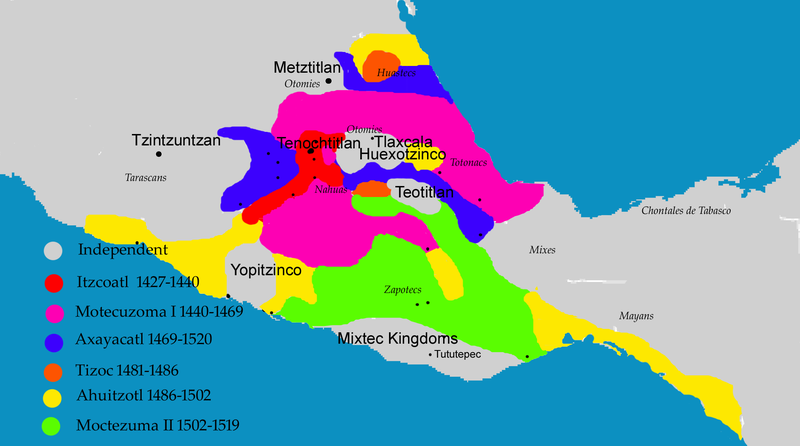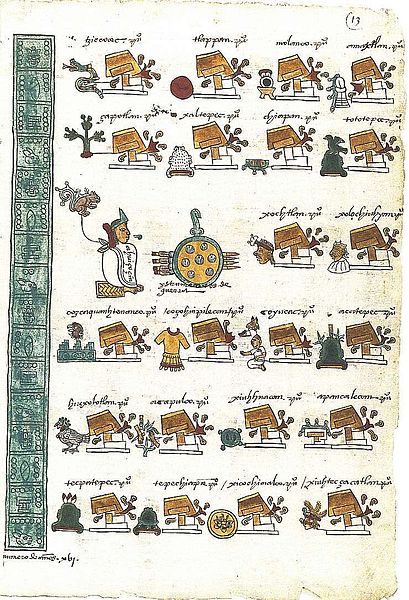 |
| Ahuitzol's conquests (in yellow) |
Ahuitzotl’s Conquests
In the first
year of his reign Ahuitzotl visited Malinalco to receive the allegiance of the
local chieftains. Ahuitzotl was unable to
extend into Tarascan lands as the Tarascans had a series of fortresses built
along the border with the Aztec empire. In answer the Aztecs built their own
fortresses south of the border at Oztoman, Oztotipac[i], and Alahuistan after a campaign
lasting from Nine Flint Knife to Ten House (1488-9). Ahuitzotl had all the
adults in these areas massacred and their children were rehomed throughout the
empire. Two thousand settlers from central Mexico were resettled in the region.
His armies
took Acapulco and then ranged north-westwards for
over one hundred miles along the Gulf Coast. After
conquering Tepoztlan[ii], near what is now Mexico City, Ahuitzotl had a temple built overlooking the Valley of Morelos and, as frequently happened, a festival of the local
deity Mayahuel[iii] was co-opted by the victors and
added to the festivities relating to agriculture celebrated in Tenochtitlan.
In the year Twelve
Reed (1491) Ahuitzotl’s armies conquered Guerrero on the Pacific coast. Here he was extending Aztec rule, as early as 1414
the Aztecs had started nibbling away at the region piecemeal. He may have been
hoping to establish a series of tributary towns in an attempt to outflank the
Tarascan forts.
 |
| List of Ahuitzol's conquests from Codex Mendoza |
Around the
year Two Rabbit (1494) Ahuitzotl’s armies conquered the central valleys of Oaxaca. The area was rich in cotton, gold and cochineal. In Five House (1497), building on his capture of the
Oaxaca region, Ahuitzotl’s armies conquered Tehuantepec. In either Seven Reed (1499) or Nine House (1501) Ahuitzotl’s armies
reached Xoconochco[iv] close to the modern day frontier of Guatemala, he subdued the region adding the cacao growing regions to his empire. Early in the new century Ahuitzotl conquered
the Huaxteca[v] peoples
This proved
to be furthest that Ahuitzotl could press his armies. Beyond Xoconochco the
supply lines became too unwieldy; although the armies usually lived off the
land their essential but bulky battle insignia, arms and other items needed
transporting, and his warriors refused to proceed further.
By the end of his life Ahuitzotl had regained most of the
lands lost during the reign of Tizoc. After each victorious campaigning season great feasts were
held and the guests were inundated with gifts, using up much of the booty from
the fighting.
Ruling
.jpg/800px-Calixtlahuaca%2C_Temple_of_Ehecatl_-_Quetzalcoatl_(20499853349).jpg) |
| Temple at Calixtlahuaca |
During his
reign Ahuitzotl came to an accommodation with the merchants of Tlatelolco; their
rumblings of discontent had been growing throughout the years of Tizoc’s reign.
He gave them extensive privileges in Tenochtitlan itself and the Aztec armies
fought on their behalf. Ahuitzotl reassigned the city of Calixtlahuaca, conquered during Axayacatl’s reign, for
colonisation by residents of the Valley of Mexico to consolidate the Aztec hold
on the region.
Ahuitzotl’s
consort was Tlilancapatl. His sons were Chimalpilli II[vi] and Cuauhtémoc[vii] and he also had a daughter. Little
is known of his personal life save that, unlike his brother Axayacatl,
Ahuitzotl was not prone to the poetry writing that characterised many previous
Tlatoani and other nobles.
Much to the
disgust of his successor, Ahuitzotl used the yardstick of service rather than
birth when appointing his officials; Moctezuma II[viii] complained bitterly that Ahuitzotl
appointed ‘men of low birth’ to be
his advisers.
End Times
_01.jpg/441px-Chalchiuhtlicue_(M._Am%C3%A9rica%2C_Madrid)_01.jpg) |
| Chalchiuhtlicue |
Ahuitzotl’s major project, apart from the Templo Mayor. was the construction of a
large canal to bring fresh water from Coyoacan
to Tenochtitlan. Ahuitzotl and his priests celebrated the completion of the
project with the priests dressed in the signature green robes of Chalchiuhtlicue, the water goddess.
‘As the water rushed in they reached down to present incense,
ground turquoise, and sacrificial quail to the life-giving element; at the same
time they spoke to the water itself as a living object of the offering.’[ix]
Some histories relate that the project got off to a bad
start when it brought so much water that it flooded the city. There was a flood
in Eight Flint Knife (1500) which destroyed many houses; Ahuitzotl was told by Netzahualpilli, Tlatoani of Texcoco, that the gods must be enraged.
Aztec legends relate tales of the terrible destruction
caused by a flood sent by Chalchiuhtlicue and
ending what the Aztecs called the fourth world. The ending of the fourth world
was followed by the fifth world, courtesy of the death of the gods. The priests
and people feared that this new major flooding presaged the ending of the fifth and
current world and the possible death of their
particular deity, the Hummingbird of the South.
 |
| Temple of the Jaguars, Malinalco |
Certainly the priests blamed the disaster on the fact that
Ahuitzotl had rashly killed the ruler of Coyoacan when he had suggested that
the canal construction project was unwise, and that the flood had been caused
by Chalchiuhtlicue in revenge. A great
reconstruction project was launched and the palaces of Tenochtitlan were
rebuilt, dykes strengthened and willows and poplars planted along the canals.
Spanish chroniclers relate that Ahuitzotl and the priests frequently
performed obsequious ceremonies to Chalchiuhtlicue to drive back floods which
must have been fairly prevalent in their lakeside city.
One of Ahuitzotl’s last projects was to arrange the
building of a temple
in Malinalco which held historical significance for the Aztecs. The work
started in Nine House (1501) using forced labour[x].
Death by Misadventure
 |
| Mictlantechuhtli |
Ahuitzotl’s reign came to a mysterious end when he allegedly
contracted a strange and fatal wasting disease, From a vigorous adult he
gradually became just skin and bone which led to suggestions that he may well
have been poisoned, like his predecessor. Ahuitzotl’s death in the year Ten
Rabbit (1502) was announced to the city by the cries of his female relatives
and other persons hired to cry out on the death of the nobility. Whilst they
cried the mourners bowed to the earth and clapped their hands. In another
version of events the king died from a blow to the head while he was trying to
escape the flood at Tenochtitlan.
Ahuitzotl’s corpse was then dressed in his finest robes by
the Tlatoani of Texcoco and tied in a squatting pose and then wrapped in cloth
and daubed in pitch. This funerary bundle was then cremated in a lavish
ceremony on a funeral pyre atop the Great Temple, in front of the temple of
Huitzilopochtli. The war captains in their full regalia along with the notable
of the Triple Alliance were also in attendance.
Aztecs were buried with supplies to help them through
their journey into the afterlife. The manner of a person’s death decided where
they would go after death. Those who died in battle entered the eastern
paradise Tonatiuhichan, joining the entourage of the sun god[xi]. They
were often accompanied by the corpse of their dog to guide them through the
afterlife.
If Ahuitzotl did die in the flood then he would have been
bound for the paradise ruled over by Tlaloc. Otherwise he was destined for the
underworld whose ruler was the skeletal god Mictlantecuhtli,
Lord of the Dead and his wife Mictecachuatl.
Those entering the underworld were doomed to;
‘Wander through eight hells for four long years. The way through
the hells was strewn with obstacles. In the first the souls of the dead were
met with a turbulent and rushing river….then they had to pass between two
mountains…..in the seventh hell wild beasts lay in wait to eat up the dead. The
soul finally came to rest in the ninth hell.’[xii]
 |
| Moctezuma II |
Ahuitzol’s ashes, along with those of his attendants[xiii] who
had been sacrificed in order to accompany him on his journey, are believed to
be buried beneath a
sculpture of Tlaltecuhtli near the Zócalo in Mexico City. Ahuitzotl had chosen his nephew Moctezuma II as his
successor and Moctezuma was duly elected to be Tlatoani.
Much of what
we know about the Aztecs comes from books such as the Codex Mendoza[xiv] and the Codex Borgia[xv] compiled by the conquering Spanish
as reports home explaining the complex culture of the enemy, so very different
than at home in Europe.
Bibliography
The Ancient
Kingdoms of Mexico – Nigel Davies, Penguin 1985
The New
World – Nicholas Hordern, Aldus Books/Jupiter Books 1971
The Ancient
American Civilisations – Friedrich Katz, Phoenix Press 2000
Moctezuma
and the Aztecs – Elisenda Vila Llonch, the British Museum Press 2009
The
Illustrated Encyclopedia of the Aztecs and Maya – Charles Phillips, Hermes House
2010
The Aztecs –
Richard F Townsend, Thames & Hudson Ltd 2010
Conquistadors
– Michael Wood, BBC Worldwide Ltd 2001
www.wkipedia.en
[i]
Now Nogales
[ii]
According to Aztec legend the birthplace of the god Quetzalcoatl
[iii]
Associated with the maguey plant
[iv]
Or Soconusco
[vii]
He became Tlatoani of Tenochtitlan after the death of his cousin Cuitlahuac, 11th
son of Axayacatl
[viii]
The last Tlatoani of the Aztecs, Moctezuma was killed during the Conquest by Hernán Cortés’ men
[ix]
The Aztecs - Townsend
[x]
The work was completed during the reign of his successor
[xi]
This concept was relatively new and was introduced shortly before the Spanish
conquest
[xii]
Ancient American Civilisations – Katz
[xiii]
On the assurance that in the next life they would be reborn as nobles
[xiv]
Created for Charles V it was sent back to Spain but the fleet was attacked by
French privateers and eventually the manuscript passed into the hands of the Bodleian Library in
the 17th century
No comments:
Post a Comment
Note: only a member of this blog may post a comment.